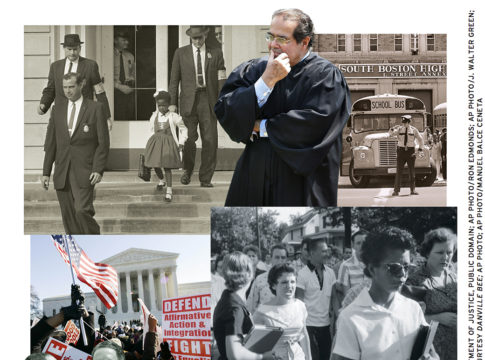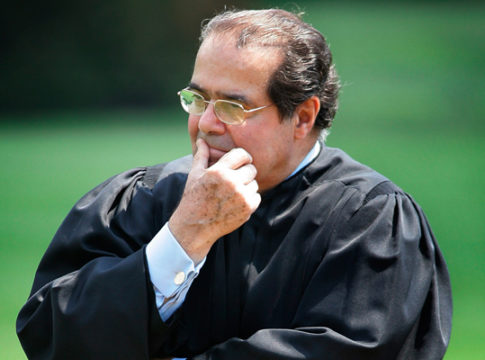Complex Justice: The Case of Missouri v. Jenkins
By Joshua M. Dunn
University of North Carolina Press, 2008, $37.50; 226 pages
As reviewed by Nathan Glazer
 If there are any school districts still under tight federal supervision of efforts to desegregate schoolchildren, more than a half century after Brown v. Board of Education, one does not hear of them. With the present posture of the Supreme Court it is unlikely any would be so hampered if an appeal against court supervision were carried that far. But until recently, school districts did operate under such supervision, often for decades after a case had originally been brought, and long after the original conditions that had motivated the case had radically changed. The Kansas City, Missouri, case, known through its long legal history as Jenkins v. State of Missouri, was perhaps the most notorious of the tortured efforts to overcome state-sanctioned segregation.
If there are any school districts still under tight federal supervision of efforts to desegregate schoolchildren, more than a half century after Brown v. Board of Education, one does not hear of them. With the present posture of the Supreme Court it is unlikely any would be so hampered if an appeal against court supervision were carried that far. But until recently, school districts did operate under such supervision, often for decades after a case had originally been brought, and long after the original conditions that had motivated the case had radically changed. The Kansas City, Missouri, case, known through its long legal history as Jenkins v. State of Missouri, was perhaps the most notorious of the tortured efforts to overcome state-sanctioned segregation.
It was notorious for many reasons: First, the court ordered enormous state and city expenditures, intending to attract white schoolchildren from the suburbs to the Kansas City schools so as to provide the minimum number of white children that proponents of desegregation considered necessary for a desegregated or “unitary” school. Second, it was an extreme example of how our legal order permits judges, and unrepresentative plaintiff lawyers, to decide how to run schools in the effort to eliminate the evil of segregation. Third, it eventually demonstrated the wide gap between what the courts and the lawyers advising them thought was necessary to improve the educational achievement of black students, and what the black community thought necessary and desirable in the education of their children.
Most cases in school segregation began when the National Association for the Advancement of Colored People (NAACP) or another group sued a school system for failure to overcome segregation. In Kansas City, uniquely, it was the school district itself that sued. In Missouri, and some other states, state-required separation of schoolchildren by race ended shortly after the Supreme Court decision in 1954. Indeed, Kansas City had received effusive praise for its voluntary compliance from the U.S. Commission on Civil Rights, from Time magazine, and from The Nation.
But a good deal had changed between 1954 and 1977, when the Kansas City Metropolitan School District (KCMSD) brought its case. Eighteen percent minority in 1954, the schools were more than 60 percent minority in 1977. Blacks were moving into cities; whites with schoolchildren were disproportionately moving to suburbs outside city boundaries. Some whites undoubtedly moved because they resisted sending their children to schools with a majority of blacks, some moved because they economically were able to and preferred the suburbs, and some feared growing urban crime in the 1960s and 1970s. Whatever the reasons, in large urban school districts, which encompassed an ever-larger proportion of black children, the only way to achieve desegregation was through busing away from neighborhood schools, a remedy approved by the Supreme Court in 1971, unpopular almost everywhere, and often ineffective as white schoolchildren could move to private schools or to the suburbs.
The KCMSD—with its schools in disrepair, without what it considered adequate funding, and having endured damaging teacher strikes—took the ingenious route of suing the state, suburban school districts, and the Department of Health, Education, and Welfare and other federal government agencies for its inability to desegregate majority black schools. The case came up before Judge Russell Clark, born 1 of 10 siblings in rural southwestern Missouri, educated in a one-room schoolhouse, and appointed by President Jimmy Carter. In 1984, after a “tortuous” seven-year discovery process and a six-month trial, Judge Clark dismissed all the defendants except the state of Missouri, and “realigned” the KCMSD as a defendant along with the state. Apparently a federal judge can turn a plaintiff into a defendant. But since the KCMSD was no longer the plaintiff, who in our adversary legal system was to represent the new plaintiffs, now presumably the black students? The NAACP, the Southern Christian Leadership Conference, the American Civil Liberties Union, all turned down the opportunity. Then stepped forward Arthur Benson, a committed liberal lawyer who was to live with the case and, together with Judge Clark, shape it, for the next 20 years or so.
Judge Clark found the state and the school district liable for segregation, and then the issue became, what was the remedy? Kansas City schools were already predominantly minority, and the Supreme Court had ruled in the Detroit case that surrounding school districts not found guilty of segregation could not be pulled into a case to provide more white students for desegregation. The approach that was developed, with the advice of education-school professors, was to create “magnet” programs, which it was hoped could draw white children from Kansas City suburbs. The judge, following the experts, decreed the rebuilding of many schools for the purpose of making them attractive to the hoped-for suburban children, an expensive enterprise. And here the chief characteristic of this case emerged: The judge, in effect, imposed higher taxes on Kansas City, and on the state, to build the new magnet schools. The appeals court and the Supreme Court (by a bare 5 to 4) approved. The figures that eventually were spent in this effort to make the schools more attractive reached, in author Joshua Dunn’s estimate, $2 billion. That may not appear to be much these days, when a single failed firm may gobble up $85 billion in government money, but recall that this was a school district, in 1984, of 37,000 students (it had fallen from 51,000 at the beginning of the case), with a budget of less than $100 million.
The distinctive contribution of Dunn’s book is to emphasize the degree to which the district judge was not acting arbitrarily (though to some degree he was), but was constrained in what he could do by an appeals court following Supreme Court decisions. Judge Clark had to find the KCMSD schools “segregated,” according to these higher-court decisions, and had to respond, limited by the Supreme Court decision that he could not require the suburbs to participate. Magnet schools with elaborate facilities to attract suburban white children was the answer proposed by the education experts, supported by the plaintiff lawyer, and implemented by the judge. It did not sit well with the black community, which by the 1980s, certainly the ’90s, was more interested in getting better education for black children than in following the will-o’-the-wisp of integration. It found the magnet school approach mystifying and infuriating. Slavic studies? A classical Greek curriculum? That is not what our children need! And even when parents and children were interested in the magnets, they were limited in getting admission because the judge had decreed there must be four whites for every six blacks in each magnet school, and often too few whites were available to expand the black quota. Despite huge expenditure, integration was not much advanced.
Finally, the Supreme Court, responding to one of many state appeals, decreed in 1995 by a 5–4 vote that Judge Clark could not impose a program of magnet schools to attract white students from the suburbs. The district remained under judicial supervision, but by then black community leaders controlled the school district, which reinstituted neighborhood schools. Judge Clark’s successor, a Reagan appointee, finally succeeded in dismissing the case in 2003. Attorney Benson, still on the case, opposed the dismissal.
The schools seemed as dysfunctional at the end as they had appeared at the beginning. But by this time, the state had approved charter schools, and substantial numbers of Kansas City’s black schoolchildren were patronizing them. In 2005–06, some 26,000 children attended the public schools, 6,000 the charter schools.
Dunn’s final word: “The court and the black community disagreed on what the problems were. Legal doctrine asserted the problem was racial isolation. The black community asserted it was substandard education.” Dunn’s contribution is to show that the issue was not an imperial judiciary that wished to reshape the schools, but a course of successful litigation in which the concentration of black children, whatever the cause, became the only target at which the courts could aim. But in the end one wonders why the Supreme Court, which the appeals courts and district judges had to follow, was so slow in recognizing the impracticality of all the measures available to try to achieve integration in major cities with large black communities.
Nathan Glazer is professor emeritus of education and sociology at Harvard University.





